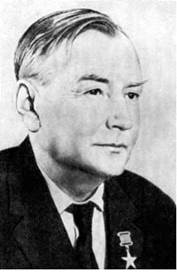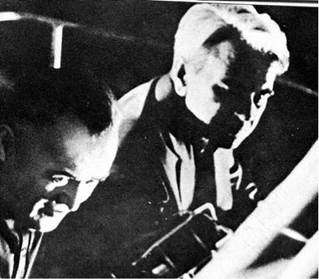Origins of the Soviet lunar programme
The Soviet moon programme began in an unlikely place – in a children’s magazine, on 2nd October 1951. Mikhail Tikhonravov was a veteran rocket engineer from the 1920s and was now convinced that a flight to the moon might soon become a practical possibility. In the paranoia of Stalin’s Russia, talking about unapproved projects like moon flights was a potentially dangerous enterprise, so he chose a relatively safe outlet, one unlikely to raise the blood pressure of the censors: the pages of Pionerskaya Pravda, the newspaper devoted to communist youth. There, on 2nd October 1951, he outlined how two men could fly out to the moon and back in a 1,000 tonne rocketship. The article concluded:
We do not have long to wait. We can assume that the bold dream of Tsiolkovsky will be realized within the next 10 to 15 years. All of you will become witness to this and some of you may even be participants in unprecedented journeys.
His article was noticed immediately by Western intelligence, which apparently scanned children’s magazines as well the main national political press. In what may have been the first occasion that Soviet space plans were noticed in the West, the New York Times noted ‘Dr Tikhonravov’s article’, commenting that Soviet advances in rockets were developing rapidly and might equal, if not exceed, Western achievements. Indeed, at official level within the Soviet Union, his article was noticed too, for when the next edition of the Great Soviet Encyclopaedia came to be written, Mikhail Tikhonravov was invited to write a section called Interplanetary communications (1954) [1].
The next step took place in April 1954, a year after the death of Stalin. Although there was no direct connexion between scientific research institute NII-4 (NII stands for Scientific Research Institute, or in Russian Nauchno Issledovatelsky Institut), where Mikhail Tikhonravov was posted and the OKB-1 experimental design bureau (in Russian, Opytno Konstrucktorskoye Buro), where the chief designer of spaceflight
|
Mikhail Tikhonravov |
Sergei Korolev worked, there was clearly a degree of informal collaboration between them. In 1946, Stalin had appointed a council of spaceflight designers and it was headed by a ‘chief designer’ (in Russian Glavnykonstruktor). The chief designer was Sergei Korolev, the legend who led the Soviet space programme from its inception. The chief designer was not just a crucial engineering post, but the political leader of the space programme, making it the most coveted position in the industry. His support was now critical.
May 1954 was the deadline for proposals for projects for countries interested in participating in the forthcoming International Geophysical Year. Encouraged, indeed prompted by Sergei Korolev, the Russian proposal was written by Mikhail Tikhon – ravov, in consultation with leading Soviet mathematician Mstislav Keldysh and Russia’s top rocket engine designer, Valentin Glushko. Called Report on an artificial satellite of the Earth, it was, according to historian Siddiqi, one of the great researchers of the period, a tour de force of foresight for the 1950s and remarkable even in the present day [2]. Even though the Soviet Union had yet to commit itself to a small Earth satellite, the writers tried to engage their country in a project for manned spaceflight from the very start. The third section of the report dealt with the problems of reaching the moon and outlined how the rocket that they were then building could send a probe to the moon and bring it back to Earth through means of atmospheric braking. Report on an artificial satellite of the Earth did not emerge from the archives until the 1990s, but it was the first mention, in an official document of plans for a Soviet flight to the moon. Although the report appeared at first sight to sink in a sea of red bureaucratic ink, in fact it became the basis of the Soviet space programme. Siddiqi says that the combination of Korolev’s managerial genius and Tikhonravov’s technical acumen became the basis of humankind’s departure from the Earth.
|
Sergei Korolev, Mstislav Keldysh |
With the Soviet Union at last thawing out from the time of terror, it was now possible to discuss lunar missions more openly. The 25th September 1955 marked the 125th anniversary of the NE Baumann Moscow Higher Technical School. Here, chief designer Sergei Korolev gave a lengthy paper called On the question of the application of rockets for research into the upper layers of the atmosphere. Here, he outlined the possibility of landing robotic probes on the surface of the moon. As the chief designer, Korolev had developed a series of rockets, derived from the German V-2, firing some with animals into the upper atmosphere. Now under Soviet Premier Nikita Khrushchev he was tasked with developing the Soviet Union’s first intercontinental ballistic missile (ICBM), capable of hitting the United States. The postwar Soviet rocket effort was driven by two complementary imperatives. The political leadership wanted missiles, while the engineers wanted rockets to explore space. Engineers had to justify their rocket building in terms of their military capability and potential. Only later did the political leadership appreciate that missiles designed for military purposes could also be powerful servants of non-military political objectives. While the intercontinental ballistic missile would indeed, Korolev knew, meet Khrushchev’s military needs, Korolev always designed the rocket with a second purpose in mind: to open the door to space travel.












